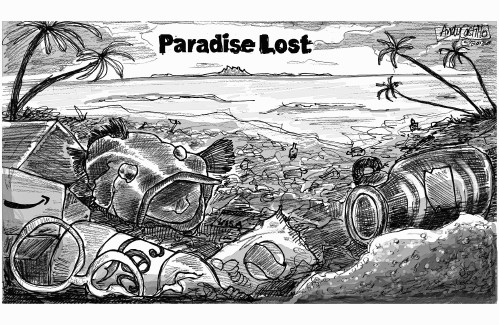Published: 3/8/2020 10:29:33 AM
A decade ago, recycling was a profitable business. Old newspapers, for example, were worth between $85 to $90 a ton. But that changed three years ago when China instituted stricter purity standards on the types of recyclable materials that were accepted.
These days, recycled newspapers are down to $10 a ton.
Since the change, Western Massachusetts communities have been shielded from these increases by a multi-year contract with the Springfield Materials Recycling Facility. Instead, Waste Management, the parent company of the Springfield recycling facility, absorbed revenue losses.
All of that will change in July.
Under a new contract between the region’s municipalities and Springfield Materials Recycling Facility, local transfer stations will have to pay either $93.50 or $145 per ton of recyclables, depending on the sorting method. For the first time, municipalities will have to pay to haul away recycling — an increase that will be paid for by area constituents.
Amid news of increasingly turbulent storms in the Caribbean Sea, raging wildfires in Australia and California, rapidly shrinking ice caps in Antarctica and yet another warmer-than-average winter in New England, a jump in recycling costs is salt in the wound.
If recycling comes at a cost, it’s a safe bet that some will forego separating their plastics altogether — a step backward in the fight against climate change.
This speaks to a broader social norm, another practice that’s unhealthy for the planet, which has become rooted in American culture: over-packaging. Just about every item in the supermarket is contained in plastic. Order guitar picks online and they’ll be mailed in plastic packaging within a plastic bag contained in a cardboard box surrounded by plastic bubble-wrap. Appliances are secured in multiple boxes by a copious amount of foam; items are shipped separately, regardless of size. The result is that once-untouched landscapes are now covered in trash. Coral reefs and other fragile habitats face real danger. Beautiful beaches are hidden by a layer of plastic. Locally, a sea of discarded Amazon boxes has taken over the Greenfield Transfer Station.
Gone are the days when beverages were sold in reusable bottles.
In a recent My Turn, Alan Owseichik recalled when “soda, beer and even milk was sold in glass containers with a cash deposit value and were returned to a store when empty and sent back to the generating company for washing and reuse. … Even newspapers were locally recycled for a cash amount paid by a scrap dealer to be processed for reuse in American paper mills.”
As a society, we’ve become accustomed to waste. America is a green economy — and not in the environmentally conscious sense. Money drives for-profit businesses.
So, why not leverage the upcoming change in recycling fees into a force for good?
Have the corporations that market the products pay for their disposal; hold Coca-Cola, Pepsi and Amazon accountable for the waste they produce. That, in turn, could bring about positive change.
Notably, we’re not the only ones who’ve proposed this action as a solution.
A bill in the state Legislature, “An Act to save recycling costs in the Commonwealth,” would require companies that manufacture consumer goods and make more than $100,000 a year in sales to contribute to a fund that would reimburse communities for recycling costs. If passed, each town or city would submit a report and receive between 60 and 80 percent reimbursement. Cities and towns would also be required to develop and submit a zero-waste plan outlining how they would reduce their waste in the future.
“All these big companies — Coca Cola, Nestle — they’re making these grand projections that by 2050 they want to have 100 percent recyclable material and they want to have 50 percent recycling of their packaging,” said John Hite, a policy analyst with the Conservation Law Foundation’s Zero Waste Project at a recent meeting about recycling with state and local legislators in Holyoke. “They’re not going to get there without programs like this. Absolutely not. When they oppose bills like this, and they do and they will, it really calls into consideration how dedicated are they really to those goals.”
By increasing the cost of producing materials that are bad for the environment, maybe businesses would put more money into eco-friendly products as a cost-saving measure. And, if the price of wasteful products were to increase, maybe America’s over-consumption mindset would revert to the 1960s, when glass milk bottles had a deposit of 25 cents.
Then, perhaps, those plastic-strewn beaches would become beautiful again. And, maybe, the vast horizon of discarded Amazon boxes at the transfer station would be replaced with greener grass along with a healthier future for the planet.


